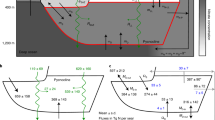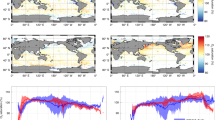Abstract
Throughout most of the year, there exists within the North Atlantic subtropical ocean mixed layer a3He excess which can only be attributed to a flux of tritiugenic3He from below. The upward flux required to support this excess can be computed as the convolution of the time series of3He excess and gas-exchange rate. This flux is quantitatively consistent with the long-term evolution of the main thermocline inventories of tritium and 3He. Using the observed correlation of 3He with nitrate within the upper main thermocline, I estimate the annually averaged upward flux of nitrate into the euphotic zone to be 0.6 ±0.2 moles m−2 per yr. This flux is sufficient to support a new, non-regenerative primary productivity in excess of 3 moles carbon m−2per yr.
This is a preview of subscription content, access via your institution
Access options
Subscribe to this journal
Receive 51 print issues and online access
$199.00 per year
only $3.90 per issue
Buy this article
- Purchase on Springer Link
- Instant access to full article PDF
Prices may be subject to local taxes which are calculated during checkout
Similar content being viewed by others
References
Schulenberger, E. & Reid, J. L. Deep Sea Res. 28, 901–919 (1981).
Jenkins, W. J. & Goldman, J. C. J. Mar. Res. 43, 465–491 (1985).
Musgrave, D. L., Chou, J. & Jenkins, W. J. J. geophys. Res. (submitted).
Jenkins, W. J. J. Mar. Res. 38, 533–569 (1980).
Jenkins, W. J. Nature 300, 246–248 (1982.
Jenkins, W. J. J. phys. Oceanogr. 17, 763–783 (1987).
Eppley, R. W. & Peterson, B. J. Nature 282, 677–680 (1979).
King, F. D. & Devol, A. H. Limnol. Oceanogr. 24, 645–651 (1979).
Garrett, C. Dyn. Atmos. Oceans 3, 239–265 (1979).
Schmitt, R. J. phys. Oceanogr. 11, 1015–1026 (1981).
Gargett, A. E. J. Mar. Res 42, 359–393 (1984).
Lewis, M. R., Harrison, W. G., Oakey, N. S., Hebert, D. & Platt, T. Science 234, 870–873 (1986).
Chou, J. Woods Hole Ocean. Inst. Rep. Summer Student Fellowship Rep. No. 42 (1985).
Jenkins, W. J. Phil. Trans. R. Soc. (in the press).
Roether, W. in Dynamic Processes in the Chemistry of the Upper Ocean (ed. Burton, J. D.) 117–128 (Plenum, New York, 1986).
Bunker, A. F. Woods Hole Ocean. Inst. tech. Rept. 75-3 (Woods Hole Oceanographic Institution, Woods Hole, Massachusetts, 1975).
Liss, P. S. & Merlivat, L. in The Role of Air-Sea Exchange in Geochemical Cycling (ed. Buat-Menard, P.) 113–127 (Reidel, New York, 1986).
Deacon, E. L. Tellus 16, 21–39 (1977).
Jenkins, W. J., Collentro, W. V. & Boudreau, R. D. Woods Hole Ocean. Inst. Helium Isotope Lab. Data Release No. 1 WHOI 79–60 (Woods Hole Oceanographic Institution, Woods Hole, Massachusetts, 1979).
Author information
Authors and Affiliations
Rights and permissions
About this article
Cite this article
Jenkins, W. Nitrate flux into the euphotic zone near Bermuda. Nature 331, 521–523 (1988). https://doi.org/10.1038/331521a0
Received:
Accepted:
Issue Date:
DOI: https://doi.org/10.1038/331521a0
This article is cited by
-
Possible transport pathway of diazotrophic Trichodesmium by Agulhas Leakage from the Indian into the Atlantic Ocean
Scientific Reports (2024)
-
The impact of eddies and spring warm pool on sinking rates of phytoplankton with different shapes and sizes
Marine Biology (2024)
-
Change in rheotactic behavior patterns of dinoflagellates in response to different microfluidic environments
Scientific Reports (2021)
-
The influence of geostrophic strain on oceanic ageostrophic motion and surface chlorophyll
Nature Communications (2019)
-
Observed and simulated submesoscale vertical pump of an anticyclonic eddy in the South China Sea
Scientific Reports (2017)
Comments
By submitting a comment you agree to abide by our Terms and Community Guidelines. If you find something abusive or that does not comply with our terms or guidelines please flag it as inappropriate.



